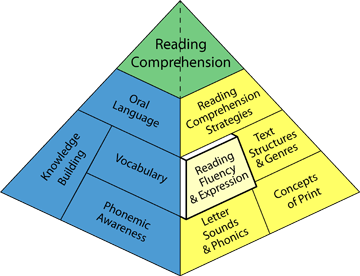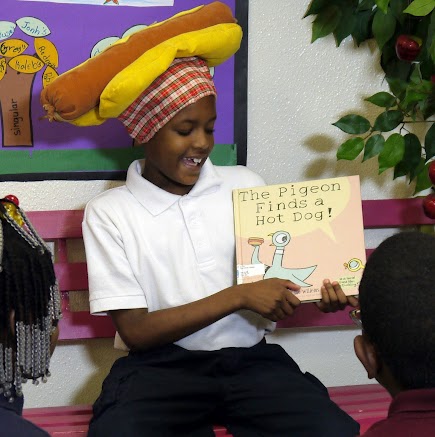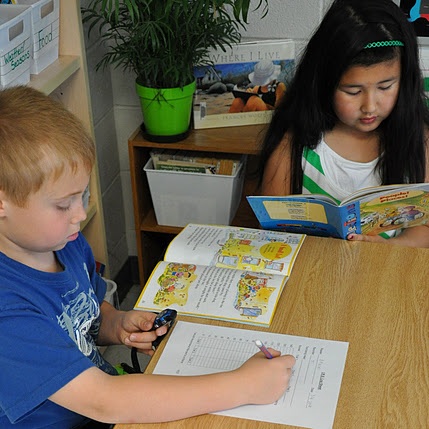Reading Fluency & Expression

What the experts say about reading fluency & expression:
If text is read in a laborious and inefficient manner, it will be difficult for the child to remember what has been read and to relate the ideas expressed in the text to his or her background knowledge.
~ National Reading Panel
By reading aloud with expression, teachers model for students meaningful, fluent reading.
~ Timothy Rasinski
A beginning reader must link letters to sounds, pay attention to spelling patterns, and figure out how these patterns work. The process is slow and analytical at the beginning.
~ J. Richard Gentry
Read more about reading fluency & expression!
-
What Works in Fluency Instruction
- Fluency: Instructional Guidelines and Student Activities
-
Developing Fluent Readers
-
Test your Understanding of Fluency
OVERVIEW of reading fluency & expression
|
|
Fluent readers recognize words quickly and read with good pacing and expression. They do not have to concentrate on figuring out each word, and can focus their attention on what the text means. Fluent readers tend to have better comprehension. The more fluency students develop, the better their comprehension will be. Although with practice word reading can become automatic, comprehension does not. |
TEACHING reading fluency & expression
|
|
It is important for students to have many opportunities to read aloud to adults and peers. Activities that encourage students to re-read texts, like reader’s theater build reading fluency. One of the goals is for students’ oral reading to sound natural, like they are talking. The texts that students use to practice should be in their “comfort zone” – not too easy, and not too difficult. |
ASSESSING reading fluency & expression
|
|
Teachers can assess reading fluency by listening to students read brief grade level passages. As you listen to students read consider the following: Does the student’s reading sound natural and smooth with pauses in the right places (as if he or she is talking)? Does the student make frequent errors? Does the student read slowly, word by word? Track student progress throughout the year.
|
Featured Videos
Fluency Phones: Amplifying Students’ Voices in Oral Reading (Virtual Tour)
Reader’s Theater: Building Fluency in Third Grade
Chants, Poems and Reader’s Theater: Building Fluency in the Upper Grades (Virtual Tour)
All Reading Fluency & Expression Recipes
 CAFÉ: Engaging Third and Fourth Grade Students in Assessment and Instruction (Virtual Tour)
CAFÉ: Engaging Third and Fourth Grade Students in Assessment and Instruction (Virtual Tour)
1st - 6th
 Guided Reading: Promoting Fluency and Comprehension in Third and Fourth Grade (Virtual Tour)
Guided Reading: Promoting Fluency and Comprehension in Third and Fourth Grade (Virtual Tour)
1st - 6th
 Guided Reading: Differentiating Instruction with Skill- and Strategy-Focused Groupings (Virtual Tour)
Guided Reading: Differentiating Instruction with Skill- and Strategy-Focused Groupings (Virtual Tour)
3rd - 6th
 What's the Text Message?: Modeling Reading Strategies through Shared Reading Activities (Virtual Tour)
What's the Text Message?: Modeling Reading Strategies through Shared Reading Activities (Virtual Tour)
1st - 4th
 Document Camera for Shared Reading: Supporting the Development of Decoding and Fluency (Virtual Tour)
Document Camera for Shared Reading: Supporting the Development of Decoding and Fluency (Virtual Tour)
K - 3rd
 Good Fit Books in First Grade: Developing Skill and a Love for Reading through Appropriate Choices (Virtual Tour)
Good Fit Books in First Grade: Developing Skill and a Love for Reading through Appropriate Choices (Virtual Tour)
K - 2nd
 Leveled Books in First Grade: Personalized Book Bins Increase Independence in Young Readers (Virtual Tour)
Leveled Books in First Grade: Personalized Book Bins Increase Independence in Young Readers (Virtual Tour)
K - 2nd
 Word Wall in First Grade: Building Sight Recognition and Spelling of High-Frequency Words (Virtual Tour)
Word Wall in First Grade: Building Sight Recognition and Spelling of High-Frequency Words (Virtual Tour)
K - 3rd
 The A in The CAFE: Improving Reading Accuracy using Meaning and Decoding Strategies (Virtual Tour)
The A in The CAFE: Improving Reading Accuracy using Meaning and Decoding Strategies (Virtual Tour)
1st - 3rd













